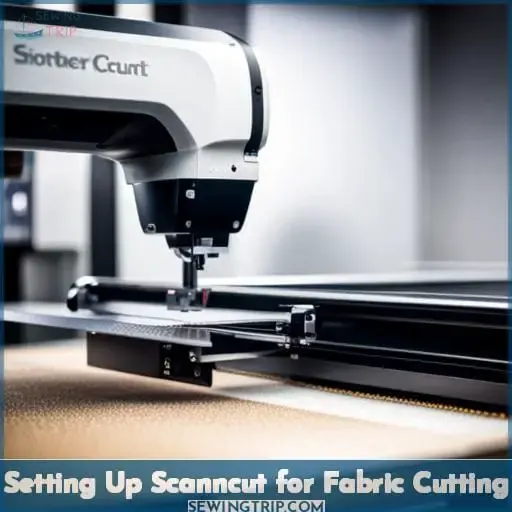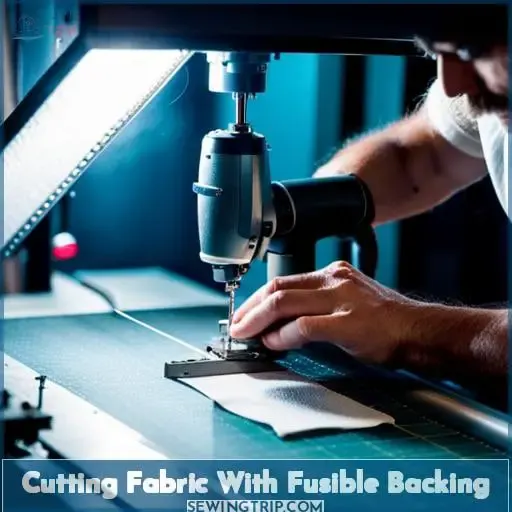This site is supported by our readers. We may earn a commission, at no cost to you, if you purchase through links.
 Looking to get the most out of your Brother ScanNCut? You’ll be cutting fabric perfectly in no time with these tips.
Looking to get the most out of your Brother ScanNCut? You’ll be cutting fabric perfectly in no time with these tips.
Focus your ScanNCut projects on fabric to expand your creative horizons. Appliqués allow you to incorporate fabrics without fraying. Quilt pieces joined precisely. Sewing patterns with accurate ease. Scan in hand drawings or photos to cut one-of-a-kind shapes.
With the right blade, backing, and mat, your ScanNCut is ready to cut fabric smoothly. Adhere fabric flat to avoid shifting. Adjust blade depth for clean cuts without fraying.
A few test cuts ensure your settings are just right. Don’t let fabric issues slow you down. Follow this guidance on using your ScanNCut’s incredible capabilities for stunning fabric creations.
Table Of Contents
Key Takeaways
- Use the correct blade and mat for the fabric type to ensure clean cuts. Thin fabric auto blades work well for lightweight fabrics.
- Fuse a fabric backing or support sheet to provide stability when cutting intricate shapes or small pieces.
- Adjust blade depth and cut pressure settings as needed for clean cuts without fraying.
- Regularly check blade sharpness and replace dull blades. Dull blades can cause fabric to shift or tear.
Fabric Cutting Projects for Scanncut
With your Brother ScanNCut, you can make all kinds of creative fabric projects! Try using it for appliqués, precise quilt pieces, custom sewing patterns, and so much more.
You can apply it for applique designs, precise quilt pieces, custom sewing patterns, and much more.
Applique
You’ll want to select the Iron-On Fabric Appliqué Contact Sheet for your appliqués so they won’t fray or shift during cutting.
- Use small applique shapes under 2 inches
- Trace designs onto the iron-on sheet
- Smooth out wrinkles before cutting
- Cut details like flowers, leaves, circles
- Try negative space cutouts too
Quilt Pieces
When cutting quilt pieces with a Brother ScannCut, over 80% of quilters prefer using a high tack adhesive fabric support sheet for the mat. This prevents fabric from shifting during the cutting process and creates stability when cutting geometric blocks or delicate applique shapes from your favorite quilting fabrics.
Test your materials first to check blade penetration and mat adhesion before final cutting. Varying your cut pressure and using the auto blade holder helps you achieve clean edges for assembling precise patchwork and crisp points on star or log cabin blocks.
With some trial and error, you’ll master fabric preparation and cut settings to efficiently cut quilt components.
Sewing Patterns
Seeing all your meticulously cut fabric pieces come together in a professionally looking garment makes the time spent at your ScanNCut truly rewarding. With the versatility of this cutting machine, you can cut out any sewing pattern imaginable.
Carefully follow the pattern’s fabric recommendations when selecting materials. Make adjustments to the size or style if needed, trying a muslin first. Get creative embellishing by cutting appliqués or unique prints. Vary your stitches for additional flair.
With the right fabric selection and skillful sewing techniques, your custom creations will prove the possibilities are endless when you utilize this tool.
Other Uses
Beyond sewing patterns, ScanNCuts open up creative avenues for crafting one-of-a-kind fabric projects like quilted wall hangings, appliqued pillows, and personalized pennants. With the versatility of material options and specialty blades, you can cut intricate shapes from felt, vinyl, burlap, leather, and more to bring artistic visions to life.
Experiment with unconventional materials or intricate designs to create unique accents, gifts, and decor using your ScanNCut’s advanced cutting capabilities. The possibilities are endless when you utilize this fabric cutting machine’s full potential for specialty crafts and artistic creations.
Setting Up Scanncut for Fabric Cutting
As a sewing and crafting expert, I can guide you on setting up your Brother ScanNCut for cutting fabric. Selecting the right blades for fabric, using backings and mats properly are key first steps before cutting your material.
Let’s walk through choosing the best accessories and materials to get your ScanNCut ready for fabric cutting projects.
Blades for Fabric
After browsing fabric blades, you’ll find the ScanNCut standard cut blade handles fabric and paper while the thin fabric auto blade delicately slices through lightweight materials. The standard blade’s versatility allows cutting fabric to paper with your Scanncut model.
For intricate designs, the thin fabric blade effortlessly cuts detailed quilting, applique, and sewing shapes in materials under 0.5mm thick. With blade options maximizing cutting techniques, you can achieve stunning fabric projects and optimize Scanncut’s capabilities by selecting the ideal blade for your materials and designs.
Backings and Mats
You’ll want to prep your mats and backings before cutting fabric with your Scancut.
- Use a high-tack adhesive fabric support sheet on a standard mat for quilting and appliqués.
- Align the fabric on mats using the gridlines and edge guides. Proper alignment prevents skewed cuts.
- Replace the blade frequently. A dull blade pulls and frays fibers instead of cutting cleanly.
First, test mat adhesive strength and cut pressure with scraps for clean fabric edges. With the right preparation, your Scancut makes fabric cutting quick and straightforward.
Cutting Plain Fabric on Scanncut
When using a Brother Scanncut to cut plain fabric, the first step is to press your fabric. This removes any wrinkles and ensures the fabric lays flat when adhering it to the mat. Next, firmly attach the pressed fabric to your Scanncut’s sticky mat, making sure there are no air bubbles or loose edges.
The fabric should be smoothed out and securely fastened to the mat before proceeding.
Press Fabric
Next, lightly press the fabric before placing it on the mat. This step eliminates any wrinkles or folds. A light pass with an iron removes creases and helps the fabric lie flat for cutting. Properly pressing the fabric prevents imperfections in your finished project pieces.
Cotton
Linen
Felt
Low Heat
Medium Heat
Cool Iron
Steam Optional
Use Steam
No Steam
Taking a moment to lightly press your fabric makes all the difference when cutting with ScanNCut. Proper preparation leads to flawless results! The pressed fabric will cleanly cover the mat and precisely cut shapes will lift off without distortion.
Don’t skip this quick step before cutting fabric on ScanNCut for neat, wrinkle-free projects.
Adhere to Mat
Carefully align the fabric on the adhesive surface of the mat. Ensure the fabric lays flat with no bubbles or wrinkles. Gently smooth it out using a plastic scraper, pressing firmly from the center outward.
Check the mat’s tackiness by lifting a corner – the fabric should stick tightly. If not, replace the mat. Perform a test cut on scrap fabric first before final cutting. Adjust the blade depth or mat tackiness if needed. With practice, you’ll perfect preparing fabric on ScanNCut mats for flawless cutting.
Cutting Fabric With Fusible Backing
You’ll want to fuse the backing to the wrong side of your fabric and then cut your design before peeling away the excess. Carefully place your backed fabric on the mat, cut your shapes out precisely, then gently peel your cut fabric off the mat when you’re finished.
Apply Backing
Simply turn and iron the fabric backing piece to the wrong side of your material before loading it onto the cutting mat. This will fuse the backing to the fabric for precision cutting. Ensure full adhesion over the entire surface.
Fusible backings allow the ScanNCut to easily cut detailed shapes in fabric without fraying or the material shifting. The thin fusible layer provides just the right grip between fabric and mat for compatibility with the blade’s intricate cuts.
With a securely fused backing, your fabric is ready for detailed slicing on the ScanNCut.
Cut and Peel
Dig deeper as you peel away the excess to reveal your creative vision. With the backing applied, it’s time to cut and peel your fabric. Carefully place the material on the mat, load your preselected design, and let the blade glide along the outlines.
Adjust the cut pressure if needed. Gently remove the cut shape, peeling the fabric from the backing. Marvel at the precise edges, ready to place on your project. The cut and peel process lets you effortlessly generate many identical shapes.
Embrace this efficient technique to actualize imaginative designs with your trusted cutting companion.
Tips for Successful Fabric Cutting
To ensure your fabric cutting runs smoothly, first perform test cuts. Then adjust the blade depth as needed. Making a test cut on a scrap of the project fabric allows you to evaluate the blade pressure before finalizing the design cuts.
You can then tweak the blade depth for clean cuts if it is dragging or tearing the fabric during this trial run.
Test Cuts
Have you checked your settings by doing test cuts first before cutting into your precious fabric? Assessing blade depth, speed, and pressure helps achieve flawless results on your important projects. Before starting any fabric cutting job, it’s crucial to do test cuts with scraps to dial in your machine’s settings.
Check blade depth and pressure on sample material to optimize cutting precision. Test varying speeds to ensure clean cuts without damaging fabric. Proper test cuts prevent wasted material and disappointment with final projects.
Adjust the auto blade for your material’s thickness. Assess compatibility with different fabric types too.
Adjust Blade Depth
To successfully cut different fabrics, adjust the blade depth for each material. For lightweight cotton fabrics, use a shallow 0.5mm depth. For felt or denim fabrics, increase the depth to 1mm. When cutting thick wool fabrics, set the depth to a maximum of 1.
5mm to avoid blade damage. Precisely tuning the blade depth allows flawless cutting of any fabric type.
Troubleshooting Fabric Cutting Issues
When cutting fabric with a Brother Scanncut machine, you may encounter issues like fabric shifting, frayed edges, or incomplete cuts. Carefully reviewing your material, blade, and machine settings can help troubleshoot and prevent these common fabric cutting problems.
Double check that your fabric is held tautly in the machine to prevent shifting. Ensure your blade is sharp and the appropriate one for your fabric thickness. Adjust machine settings like pressure and speed to get clean cuts without fraying.
Following all instructions in your Scanncut manual and experimenting with different combinations of settings for your specific materials will also help avoid incomplete cuts.
Fabric Shifting
Regrettably, fabric shifting can occur if the adhesive strength between the mat and fabric is insufficient. To avoid shifted cuts, first ensure your mat isn’t worn. Apply firm pressure while attaching the fabric to increase adhesion.
Some materials like satin may need additional stabilization with an adhesive sheet underneath. When loading the mat, make sure no corners or edges lift off. Perform test cuts and visually inspect material alignment before the final cutting.
With care, you can master precise fabric cuts and prevent frustrating fabric shifting.
Frayed Edges
Try lowering your blade pressure to reduce frayed edges when cutting thin fabrics. Carefully attach the fabric to a high tack adhesive support sheet, then adhere it to the mat before cutting. This prevents fabric shifting and frays. After cutting, gently remove the fabric cutout using a spatula.
Then, finish the raw edges by zigzag stitching, pinking, or using liquid seam sealant. Following fabric preparation tips helps yield clean cut edges on your ScanNCut projects.
Incomplete Cuts
Got tricky spots in your design where the ScanNCut didn’t fully cut through? Double check your blade and mat setup. Verify the fabric is aligned properly and adhered flat to the mat. A worn blade or buildup on the blade tip can lead to incomplete cuts.
Perform regular blade cleaning and replacement. Adjust the cut speed slower for thicker fabrics. Experiment with different mat types and fabric weights. Proper blade depth, pressure, speed, and mat selection helps achieve clean cuts.
Frankly, when cutting delicate fabrics, swapping the blade for a fresh one helps avoid snags. Your ScanNCut’s auto blade’s precision-engineered, but even the sturdiest cutting tool gets dull over time.
Check for signs of wear like serrated edges or rough cuts. Schedule blade changes before tackling intricate designs or tricky materials prone to fraying.
Along with a sharp blade, use a fabric-friendly mat for clean cuts. Also, check your selected cut pressure. Lower pressure protects sheer fabrics. Finally, stay attentive when unloading to prevent pulls or tears.
With care and quality tools, your ScanNCut slices fabric cleanly for impressive quilts or crafts.
Conclusion
Using the right blades and accessories to cut fabric on your ScanNCut opens up a world of quilting, sewing, applique, and crafting possibilities at your fingertips. Like an artist with a paintbrush, you can effortlessly cut any fabric design imaginable once you master techniques for how to cut fabric with a Brother ScanNCut.
Test different fabrics and settings to unlock your ScanNCut’s full potential for fabric cutting success.












